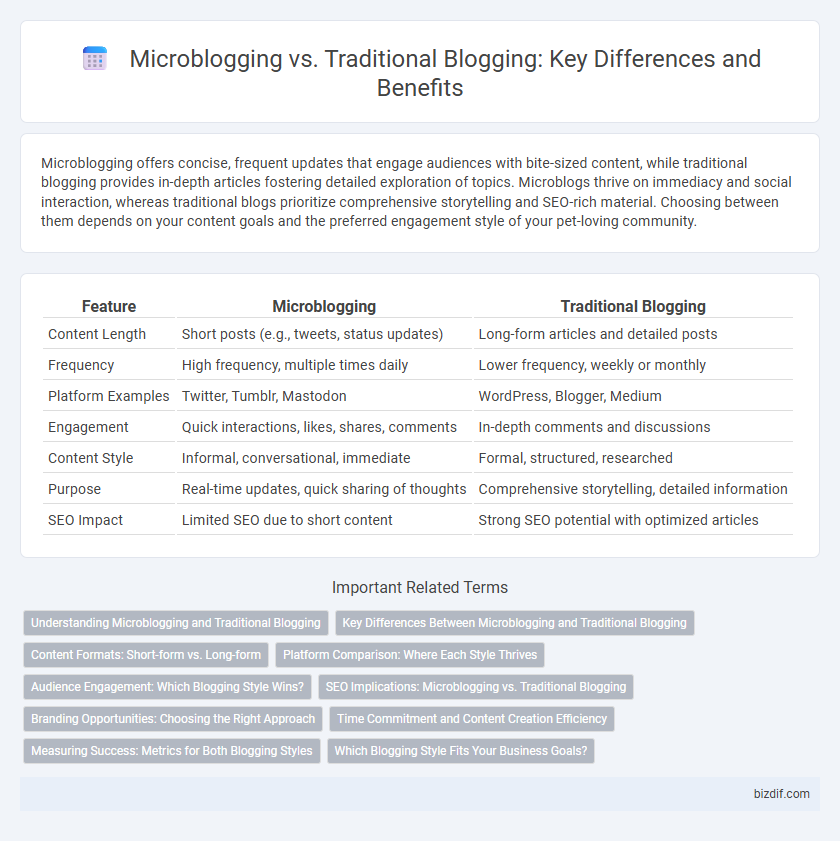Microblogging offers concise, frequent updates that engage audiences with bite-sized content, while traditional blogging provides in-depth articles fostering detailed exploration of topics. Microblogs thrive on immediacy and social interaction, whereas traditional blogs prioritize comprehensive storytelling and SEO-rich material. Choosing between them depends on your content goals and the preferred engagement style of your pet-loving community.
Table of Comparison
| Feature | Microblogging | Traditional Blogging |
|---|---|---|
| Content Length | Short posts (e.g., tweets, status updates) | Long-form articles and detailed posts |
| Frequency | High frequency, multiple times daily | Lower frequency, weekly or monthly |
| Platform Examples | Twitter, Tumblr, Mastodon | WordPress, Blogger, Medium |
| Engagement | Quick interactions, likes, shares, comments | In-depth comments and discussions |
| Content Style | Informal, conversational, immediate | Formal, structured, researched |
| Purpose | Real-time updates, quick sharing of thoughts | Comprehensive storytelling, detailed information |
| SEO Impact | Limited SEO due to short content | Strong SEO potential with optimized articles |
Understanding Microblogging and Traditional Blogging
Microblogging involves sharing brief, frequent updates typically through platforms like Twitter and Tumblr, emphasizing real-time interaction and concise content. Traditional blogging features longer, in-depth posts published on platforms such as WordPress and Blogger, allowing for detailed exploration of topics and extensive multimedia integration. Understanding these differences helps content creators choose the right format for audience engagement, speed of communication, and content depth.
Key Differences Between Microblogging and Traditional Blogging
Microblogging platforms like Twitter and Tumblr emphasize brief, concise updates often limited to a few sentences or multimedia content, enabling rapid sharing and real-time engagement. Traditional blogging allows for in-depth articles, comprehensive analysis, and extensive storytelling, typically hosted on personal or professional websites with longer publishing cycles. The key differences include content length, audience interaction speed, and the level of detail, where microblogging favors immediacy and brevity while traditional blogging prioritizes depth and thoroughness.
Content Formats: Short-form vs. Long-form
Microblogging emphasizes short-form content such as tweets, status updates, and brief multimedia posts that cater to quick consumption and real-time engagement. Traditional blogging predominantly features long-form articles, in-depth analysis, and comprehensive storytelling designed for detailed exploration of topics. Both formats serve distinct audience preferences, with microblogging prioritizing immediacy and brevity, while traditional blogging allows for extensive content depth and SEO optimization.
Platform Comparison: Where Each Style Thrives
Microblogging platforms like Twitter and Instagram excel in rapid, real-time content sharing and audience engagement through brief, easily consumable posts, ideal for trending topics and quick updates. Traditional blogging platforms such as WordPress and Medium provide extensive space for in-depth articles, SEO optimization, and comprehensive storytelling, catering to readers seeking detailed information and long-form content. Brands and creators aiming for immediate interaction prioritize microblogging, while those focusing on evergreen content and authority building prefer traditional blogging platforms.
Audience Engagement: Which Blogging Style Wins?
Microblogging drives higher audience engagement through concise, frequent updates that cater to fast-paced consumption habits, making content easily shareable across social media platforms. Traditional blogging excels in depth and storytelling, attracting readers seeking comprehensive insights and fostering loyal community interaction through detailed comments and discussions. Microblogging often wins in immediate interaction metrics, while traditional blogging cultivates sustained engagement over time through richer, more immersive content.
SEO Implications: Microblogging vs. Traditional Blogging
Microblogging offers rapid content updates with concise, keyword-rich posts that can boost SEO by increasing user engagement and frequent indexing by search engines. Traditional blogging provides in-depth articles that target long-tail keywords, enhancing organic search visibility and authority through comprehensive content. Combining both strategies can optimize search presence by leveraging microblogging's immediacy and traditional blogging's detailed SEO advantages.
Branding Opportunities: Choosing the Right Approach
Microblogging offers rapid content dissemination and high engagement through concise posts, ideal for real-time brand interaction and building a dynamic online presence. Traditional blogging provides in-depth storytelling and SEO advantages, enhancing brand authority and long-term audience trust. Selecting the right approach depends on target audience behavior, content goals, and desired brand positioning across digital platforms.
Time Commitment and Content Creation Efficiency
Microblogging demands significantly less time commitment compared to traditional blogging, making it ideal for quick updates and frequent posting. Content creation efficiency is higher with microblogging due to shorter, concise posts that require minimal drafting and editing. Traditional blogging, however, involves more in-depth content that necessitates thorough research and longer production times.
Measuring Success: Metrics for Both Blogging Styles
Microblogging success is often measured by engagement metrics such as likes, shares, comments, and follower growth due to its rapid content consumption and real-time interaction. Traditional blogging emphasizes metrics like page views, average session duration, bounce rate, and conversion rates that reflect in-depth reader engagement and SEO performance. Both styles benefit from tracking user interaction data, but the key performance indicators vary according to content format and audience behavior.
Which Blogging Style Fits Your Business Goals?
Microblogging delivers short, impactful content that boosts real-time engagement, ideal for businesses seeking rapid audience interaction and frequent updates. Traditional blogging supports in-depth analysis and storytelling, making it suitable for brands aiming to establish authority and improve SEO over time. Choosing the right style depends on your business goals, target audience, and content strategy, balancing immediacy with depth to maximize impact.
Microblogging vs Traditional Blogging Infographic

 bizdif.com
bizdif.com